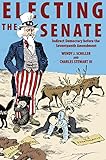Electing the Senate : Indirect Democracy before the Seventeenth Amendment / Charles Stewart, Wendy J. Schiller.
Material type: TextSeries: Princeton Studies in American Politics: Historical, International, and Comparative Perspectives ; 146Publisher: Princeton, NJ : Princeton University Press, [2014]Copyright date: ©2015Edition: Pilot project. eBook available to selected US libraries onlyDescription: 1 online resource (256 p.) : 13 line illus. 21 tables. 4 mapsContent type:
TextSeries: Princeton Studies in American Politics: Historical, International, and Comparative Perspectives ; 146Publisher: Princeton, NJ : Princeton University Press, [2014]Copyright date: ©2015Edition: Pilot project. eBook available to selected US libraries onlyDescription: 1 online resource (256 p.) : 13 line illus. 21 tables. 4 mapsContent type: - 9780691163178
- 9781400852680
- POLITICAL SCIENCE / Political Process / Campaigns & Elections
- Senate elections
- Senate representation
- Senate seat
- Seventeenth Amendment
- U.S. Constitution
- U.S. Senate
- U.S. senator
- direct election
- direct elections
- electoral systems
- federalism
- indirect election
- indirect elections
- institutional representation
- legislative activity
- partisanship
- party caucus
- political candidates
- political control
- political corruption
- political parties
- political party leaders
- public vote
- representational behavior
- senators
- state elections
- state legislator
- state legislature
- state legislatures
- 328.730734 23
- JK1965 .S45 2017
- online - DeGruyter
- Issued also in print.
| Item type | Current library | Call number | URL | Status | Notes | Barcode | |
|---|---|---|---|---|---|---|---|
 eBook
eBook
|
Biblioteca "Angelicum" Pont. Univ. S.Tommaso d'Aquino Nuvola online | online - DeGruyter (Browse shelf(Opens below)) | Online access | Not for loan (Accesso limitato) | Accesso per gli utenti autorizzati / Access for authorized users | (dgr)9781400852680 |
Browsing Biblioteca "Angelicum" Pont. Univ. S.Tommaso d'Aquino shelves, Shelving location: Nuvola online Close shelf browser (Hides shelf browser)

|

|

|

|

|

|

|
||
| online - DeGruyter Defining Neighbors : Religion, Race, and the Early Zionist-Arab Encounter / | online - DeGruyter The Impression of Influence : Legislator Communication, Representation, and Democratic Accountability / | online - DeGruyter Paradoxes of Liberal Democracy : Islam, Western Europe, and the Danish Cartoon Crisis / | online - DeGruyter Electing the Senate : Indirect Democracy before the Seventeenth Amendment / | online - DeGruyter The Silent Sex : Gender, Deliberation, and Institutions / | online - DeGruyter Economic Interdependence and War / | online - DeGruyter Being German, Becoming Muslim : Race, Religion, and Conversion in the New Europe / |
Frontmatter -- Contents -- Illustrations -- Tables -- Preface -- Chapter 1. Introduction -- Chapter 2. A Theory of Indirect Election -- Chapter 3. Candidate Emergence, Political Ambition, and Seat Value -- Chapter 4. Party as Gatekeeper: Canvass, Convention, and Caucus as Nomination Mechanisms -- Chapter 5. Political Dynamics and Senate Representation -- Chapter 6. Senate Electoral Responsiveness under Indirect and Direct Election -- Chapter 7. Myth and Reality of the Seventeenth Amendment -- References -- Index
restricted access online access with authorization star
http://purl.org/coar/access_right/c_16ec
From 1789 to 1913, U.S. senators were not directly elected by the people-instead the Constitution mandated that they be chosen by state legislators. This radically changed in 1913, when the Seventeenth Amendment to the Constitution was ratified, giving the public a direct vote. Electing the Senate investigates the electoral connections among constituents, state legislators, political parties, and U.S. senators during the age of indirect elections. Wendy Schiller and Charles Stewart find that even though parties controlled the partisan affiliation of the winning candidate for Senate, they had much less control over the universe of candidates who competed for votes in Senate elections and the parties did not always succeed in resolving internal conflict among their rank and file. Party politics, money, and personal ambition dominated the election process, in a system originally designed to insulate the Senate from public pressure.Electing the Senate uses an original data set of all the roll call votes cast by state legislators for U.S. senators from 1871 to 1913 and all state legislators who served during this time. Newspaper and biographical accounts uncover vivid stories of the political maneuvering, corruption, and partisanship-played out by elite political actors, from elected officials, to party machine bosses, to wealthy business owners-that dominated the indirect Senate elections process. Electing the Senate raises important questions about the effectiveness of Constitutional reforms, such as the Seventeenth Amendment, that promised to produce a more responsive and accountable government.
Issued also in print.
Mode of access: Internet via World Wide Web.
In English.
Description based on online resource; title from PDF title page (publisher's Web site, viewed 30. Aug 2021)


